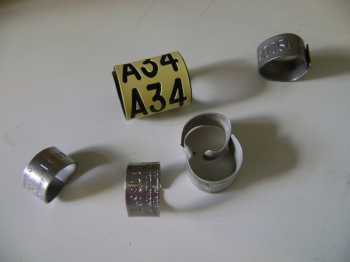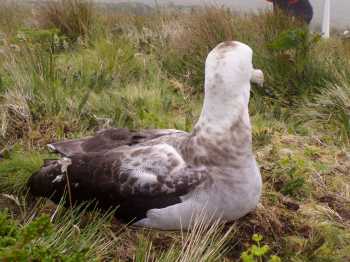A pelagic longliner operating in international waters in the south-west Atlantic pulled aboard a drowned albatross wearing a colour band on 4 October 2011 at 33.24S, 47.09W. Because the colour band was handed in to Proyecto Albatros y Petreles in Uruguay as part of its Ring Recovery Campaign (click here) along with a metal band of the British Antarctic Survey (BAS) it was originally thought that the banded bird must have been a Wandering Albatross Diomedea exulans from Bird Island. However, on checking it was found the two bands did not match up in BAS records and so could not have come from the same bird, leaving an unsolved mystery.

The recovered Tristan Albatross colour band among Wandering Albatross metal bands
Photograph courtesy of Sebastian Jimenez
Looking at a photograph of the band (yellow A34) I recognized it to be of the same size, colour and design as the Canadian Pro-Touch Engraving bands used on Tristan Albatrosses D. dabbenena on Gough Island. Further research at BAS and in South Africa confirmed it could not have been placed on a giant petrel Macronectes spp. in the South Atlantic – which take smaller bands.
I banded yellow A34 (with SAFRING metal band J-15697) as an incubating female Tristan Albatross in the first season of a new long-term study colony in Gonydale on Gough Island on 4 February 2007. At the time I photographed it to aid in assigning gender, unfortunately with its head turned away. It bred successfully that year, partnered with yellow B56, with its chick banded in September and assumed to have fledged.
 Yellow A34 on Gough Island. Photograph by John Cooper
Yellow A34 on Gough Island. Photograph by John Cooper
Yellow A34 and B46 were next reported incubating in Gonydale during January 2010 but by 12 July they had lost their chick, likely to attacks by the introduced “killer” House Mice Mus musculus. Yellow A34 was not reported breeding subsequently.
This is the fifth Tristan Albatross recovery reported from South America. Click here to read about one of these, yellow B43. Click here to read about yet another Gonydale Tristan Albatross (yellow A43) caught by a fishing vessel from Namibia.
With thanks to Chris Bell, Sebastian Jimenez, Kalinka Rexer-Huber, Juan Pablo Seco Pon and Andy Wood for information.
John Cooper, ACAP Information Officer, 19 February 2013

 English
English  Français
Français  Español
Español